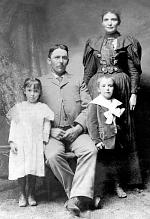 |
 The Buzby Family – An Alaska Pioneer Family A A AHarry Buzby's 1907 Crop Report
H. Buzby, Fairbanks, December 9, 1907. — On June 23, 1907, I received from the Sitka Experiment Station 2 red currants, 2 white currants, and 6 red raspberry roots. On June 30 I received from the same station 2 Whitney, 2 Duchess, 1 Strawberry apple tree, and 1 seedling plum tree. They had been on the road about 30 days and had all made from 4 to 8 inches of growth while packed. I placed them in a good location in good ground. The growth on the currant and raspberries died down, but a second growth started the last part of July. The plum and apple trees kept on growing and went into the winter in good shape. Snow fell October 10 and 15 to the depth of 15 inches. The winter has been very fine up to this date and I think the trees will winter all right. Will report next summer. Our vegetable crop last season was fine. I sowed a small plat of Macaroni wheat and Silver King barley on May 10. The barley was fine and fit to cut for seed August 10. The wheat made a good growth and filled well and was in the hard dough when I cut it August 25.  Last season was a little cool here, but no frost after the spring frosts were over until September 1. There were great quantities of farm produce raised in this part of the Tanana Valley. The only question now is to bring the soil to as high a state of cultivation as possible and plant the very best seed and plant early. I planted potatoes April 29. They had been started in the greenhouse and had sprouts well developed; those potatoes were the best we had. We planted at intervals until June 1. Of all the root crops the first plantings were the best in every instance. We planted all our peas the last part of April; the crop was excellent; some of the late varieties made a growth of 7-1/2 feet and were loaded with fine peas. We planted Alaska, Early Prolific, Gradus, Centennial, Horsford Market Garden, Champion of England, and some field peas, and had peas from July 15 to September 10. We sold cauliflower (Maule Prize Early) July 22, cabbage (Estampes) same date, carrots July 24, turnips June 26, beets June 25, all from plantings made outdoors. Our rhubarb (Victoria), from yearling roots, transplanted last spring was fine. We raised onions (Silver Skin) from the seed that made good marketable onions and ripened nicely. Have some in the cellar at this time; are perfectly firm. There will be several acres of potatoes planted in and near Fairbanks next season.
Back to the top
Matanuska Peak photo courtesy of Teressa Van Diest |